Join us for conversations that inspire, recognize, and encourage innovation and best practices in the education profession.
Available on Apple Podcasts, Spotify, Google Podcasts, and more.
Look for the following topics in the video, indicated by the ![]() onscreen icon, and click below to learn more.
onscreen icon, and click below to learn more.
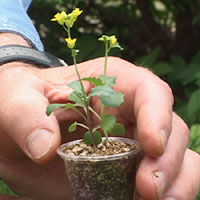 Artificial Selection at Work |
 Darwin and Natural Selection |
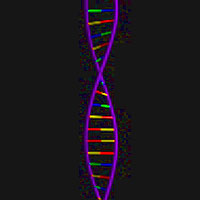 DNA, Chromosomes, and Genes |
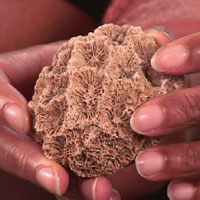 New Variation in Populations |
 Scientist at Work |
Curriculum Resources |
Artificial selection is the intentional reproduction of individuals in a population that have desirable traits. In organisms that reproduce sexually, two adults that possess a desired trait — such as two parent plants that are tall — are bred together. In this example, the mechanisms of heredity dictate that the next generation will consist of more tall plants than previous generations. If artificial selection is continued, all of the population will ultimately be tall. Also called selective breeding, artificial selection is perhaps best understood as a contrast to natural selection, where the random forces of nature determine which individuals survive and reproduce. In both cases, the outcome is the same: a population changes over time, so that certain traits become more common.
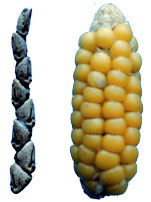
Teosinte (left) and its modern descendent, corn, a product of artificial selection
Artificial selection has generated untold diversity in both plants and animals. In agriculture, superior strains of corn, wheat, and soybeans have resulted from careful breeding. The Brassicas described by Paul Williams in the video are great examples of artificial selection. Cabbage, broccoli, cauliflower, Brussels sprouts, collards, and kale are all members of the same species, Brassica oleracea. Gardeners have cultivated flowers such as roses and orchids, carefully manipulating heredity to produce the “perfect” hybrid.
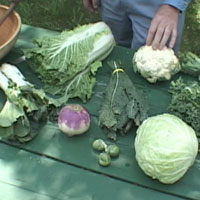
A variety of vegetables of the Brassica oleracea species
Some consider domesticated animals to be the ultimate products of artificial selection. Thoroughbred racehorses are one example of artificial selection of animals. The meats we eat are the result of the careful selective breeding of cows, pigs, sheep, and chickens. Our pets are a far cry from their “wild” ancestors. Cats and dogs, which were originally domesticated for pest control, hunting, or shepherding, eventually were bred to become companion animals. A glance at a group of dogs — all of the species Canis familiaris — reveals an astounding diversity of body type, size, and coloration.
There can be a down side to artificial selection. Because this process essentially removes variation in a population, selectively bred organisms can be especially susceptible to diseases or changes in the environment that would not be a problem for a natural population. Inbreeding — the mating of closely related individuals — is also a problem. In dogs, this has resulted in breeds that have health issues ranging from decreased life span to hip dysplasia.
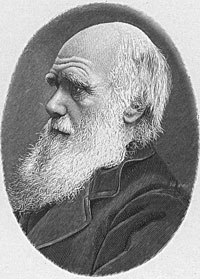
Charles Darwin
The diversity of the living world has long inspired naturalists and scientists to speculate on its origin. Up until the 19th century, the most popular explanation for the diversity of life on Earth was a supernatural force or god(s). It wasn’t until Charles Darwin’s work in the mid-1800s that the scientific and lay communities began to seriously consider the possibility that life evolved from ancestral forms by strictly natural processes.
As a naturalist aboard the H.M.S. Beagle, Darwin made observations – particularly in the Galapagos Islands —that would later be the foundation for his theory of evolution. What distinguished his theory from others at the time — such as Jean-Baptiste Lamarck’s theory of evolution by the inheritance of acquired traits — was his proposal of natural selection as the mechanism.
Darwin was acquainted with principles set forth by the economist Thomas Malthus, who wrote of overpopulation in the context of human civilization. Malthus observed that humans produce more offspring than their food supply can support, which makes competition for limited resources inevitable. Darwin saw connections to the natural world, where habitats are often populated by organisms that have a much greater capacity to reproduce than the environment has the capacity to support. Darwin was also knowledgeable about the practice of artificial selection, where humans essentially direct evolution by manipulating heredity.
Applying these ideas to the natural world, Darwin envisioned a “struggle for survival” where those that survived were somehow more “fit” — that is, better suited for that particular environment. Darwin proposed that “survival of the fittest” resulted in differential reproduction, where those individuals in a population that possessed beneficial traits would produce more offspring. This was natural selection, where nature “selects” which variants in a population survive and reproduce. Darwin proposed that, over time, natural selection results in evolution.
In 1859, Darwin published his life’s work, “The Origin of Species.” The theory of evolution by natural selection rocked the scientific community as well as the public. Interestingly, another scientist, Alfred Russell Wallace, had conceptualized evolution by natural selection. Darwin, however, generally receives the credit.

DNA double helix
The genome of an organism — its pool of hereditary material— is composed of an organic molecule called deoxyribonucleic acid, or DNA. DNA is a double helix, a spiral-shaped molecule that can be compared to a zipper. The two outer lengths exist as a supportive structure, with the “teeth” consisting of bases on each side that interlock together as base pairs. The bases are molecular sub-units and there are of only four types— adenine (A), thymine (T), cytosine (C) and guanine (G). This four-letter “alphabet” forms the codes for all of an organism ’s traits.
In eukaryotic organisms, DNA is found in the nucleus and is organized in rod-like structures of varying size and shape called chromosomes. Chromosomes contain both DNA and protein, with the DNA being wrapped around the protein, which preserves its shape. Chromosomes exist in the nucleus in chromosome pairs, with the members of each pair containing information that codes for the same traits — like having two sets of hereditary recipe books containing the same recipes. The entire genome exists in each of an organism’s body cells (with some exceptions — like alternation of generations in plants). In human beings, for example, there are 46 chromosomes organized as 23 pairs.
Genes are lengths of DNA that carry information for a particular trait. Each gene occupies a specific position on a specific chromosome, with the same gene being found in the same place on each member of a chromosome pair. Each gene consists of a sequence of the bases A, T, C, and G. Genes give rise to proteins, which ultimately result in the expression of traits.
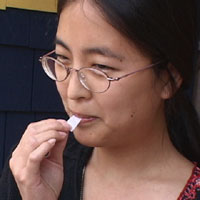
Subject tastes PTC paper
Within a population of organisms, there can be variation in the information contained in one gene. These variants are called alleles, and they differ because their sequence of bases differs. For example, one gene dictates peoples’ ability to taste phenol thiocarbamide or PTC, as was featured in the video. One allele codes for the ability to taste PTC while another codes for the opposite. An individual’s combination of alleles for any given gene determines which traits are expressed. For many traits, there are numerous alleles, and multiple genes control many traits.
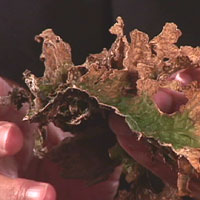
Lichen: an example of symbiosis, another way to produce new variants.
A population of organisms — a group of individuals of the same species — represents a pool of hereditary material that is collectively called the genome of the species. In this genome are genes, which code for all of the traits that make an organism what it is. A look at individuals in any population reveals an amazing amount of variation for any given trait — height in human beings or coat color in dogs, for example. Behind this variation are differences in the code in the genes. At any given time, a population can be characterized by having traits that vary in certain ways. But how does new variation arise?
A critical part of cell reproduction involves the replication of a cell’s entire set of chromosomes. Although replication is remarkably reliable, errors do occur and result in changes in the sequence of bases in a gene. Parts of a gene may be deleted, substituted, or doubled, for example. An error like this is referred to as a mutation. Mutation is one of the key sources of new variation in genes. Mutations may or may not be harmful.
Whether or not the mutation is expressed in the next generation of individuals in a population depends on where the mutation occurs. If it occurs in an organism’s body cells, the mutation will only appear in subsequent generations of the affected body cells. If the mutation occurs as sex cells are being produced, the mutation may be passed on to the next generation through the affected individual’s sperm or eggs. This is thought to be one of the most important ways that new variation arises in a population.
 Dr. Georgia Dunston is professor and chair of the Department of Microbiology at Howard University College of Medicine, and founding director of the newly formed National Human Genome Center (NHGC) at Howard University. Her research on human genome variation in disease susceptibility has been at the vanguard of current efforts at Howard University to build national and international research collaborations focusing on the genetics of diseases common in African Americans and other African Diaspora populations. Dr. Dunston is program director of the coordinating center for the Africa America Diabetes Mellitus Study, an international collaboration to study the genetics of type 2 diabetes in ancestral populations of African Americans, and the coordinating center for the African American Hereditary Prostate Cancer Study Network, a national cooperative formed to map and characterize genes for prostate cancer in African Americans. The NHGC is instrumental in bringing multicultural perspectives and resources to an understanding of knowledge gained from the Human Genome Project and research on human genome variation.
Dr. Georgia Dunston is professor and chair of the Department of Microbiology at Howard University College of Medicine, and founding director of the newly formed National Human Genome Center (NHGC) at Howard University. Her research on human genome variation in disease susceptibility has been at the vanguard of current efforts at Howard University to build national and international research collaborations focusing on the genetics of diseases common in African Americans and other African Diaspora populations. Dr. Dunston is program director of the coordinating center for the Africa America Diabetes Mellitus Study, an international collaboration to study the genetics of type 2 diabetes in ancestral populations of African Americans, and the coordinating center for the African American Hereditary Prostate Cancer Study Network, a national cooperative formed to map and characterize genes for prostate cancer in African Americans. The NHGC is instrumental in bringing multicultural perspectives and resources to an understanding of knowledge gained from the Human Genome Project and research on human genome variation.
 Dr. Robert Murray serves as professor of pediatrics and medicine and chief of the Division of Medical Genetics in the Department of Pediatrics and Child Health in the College of Medicine at Howard Medical School. In addition, he is graduate professor and chairman of the Graduate Department of Genetics and Human Genetics, which offers both M.S. and Ph.D. degrees through the Graduate School of Arts and Sciences, also at Howard University. He has authored or co-authored more than 80 publications including four books — most recently, The Human Genome Project and the Future of Health Care. Dr. Murray is a fellow of the American Association for the Advancement of Science, a fellow and member of the board of directors of the Hastings Center, a fellow of the Institute of Medicine, National Academy of Sciences, and a former member of its governing council. He has been a member of the Mammalian Genetics Study Section of the Division of Research Grants, NIH, the National Advisory General Medical Sciences Council of NIGMS, NIH, and the Bioethics Advisory Committee to the Secretary of DHEW 1979-81. He is a member of the American Board of Internal Medicine and the American Board of Medical Genetics.
Dr. Robert Murray serves as professor of pediatrics and medicine and chief of the Division of Medical Genetics in the Department of Pediatrics and Child Health in the College of Medicine at Howard Medical School. In addition, he is graduate professor and chairman of the Graduate Department of Genetics and Human Genetics, which offers both M.S. and Ph.D. degrees through the Graduate School of Arts and Sciences, also at Howard University. He has authored or co-authored more than 80 publications including four books — most recently, The Human Genome Project and the Future of Health Care. Dr. Murray is a fellow of the American Association for the Advancement of Science, a fellow and member of the board of directors of the Hastings Center, a fellow of the Institute of Medicine, National Academy of Sciences, and a former member of its governing council. He has been a member of the Mammalian Genetics Study Section of the Division of Research Grants, NIH, the National Advisory General Medical Sciences Council of NIGMS, NIH, and the Bioethics Advisory Committee to the Secretary of DHEW 1979-81. He is a member of the American Board of Internal Medicine and the American Board of Medical Genetics.
Exploring With Wisconsin Fast Plants is a resource manual targeted for middle school and elementary teachers, but widely used as a source of ideas at high school and college levels. Exploring With Wisconsin Fast Plants includes complete growing information and dozens of classroom activities
Nine sections assist teachers in aligning with the American Association for the Advancement of Science’s Benchmarks for Science Literacy, and the National Research Council’s National Science Education Standards. For more information, contact:
Kendall/Hunt Publishing Company
1-800-542-6657
http://www.kendallhunt.com/